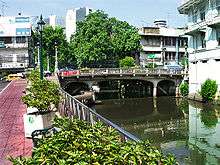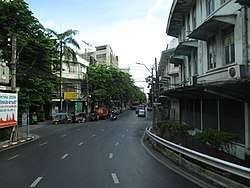Phitthaya Sathian Bridge
Phitthaya Sathian Bridge (Thai: สะพานพิทยเสถียร) is a historic bridge in the Bangkok's Talat Noi sub-district, Samphanthawong district. It's considered as another iron bridge of Bangkok counterpart with the Damrong Sathit Bridge, popularly known as Saphan Lek, which site in the area of Khlong Thom. Phitthaya Sathian Bridge is the bridge on Charoen Krung road across Khlong Phadung Krung Kasem and considered to be the end of Samphanthawong. The next district is Bang Rak.
Phitthaya Sathian Bridge สะพานพิทยเสถียร | |
|---|---|
 | |
| Coordinates | |
| Carries | Charoen Krung Road |
| Crosses | Khlong Phadung Krung Kasem |
| Locale | Talat Noi Sub-District, Samphanthawong District, Bangkok, Thailand |
| Official name | Phitthaya Sathian Bridge |
| Other name(s) | Saphan Lek Lang (Lower Iron Bridge) |
| Maintained by | Bangkok Metropolitan Administration (BMA) |
| Characteristics | |
| Design | Venetian Gothic |

| |
When the new construction in the reign of King Mongkut (Rama IV), the structure is iron and can be separated from each other for the boat pass similar to lifting bridge. So it was named "Saphan Lek" in Thai, and is often called "Saphan Lek Lang" (สะพานเหล็กล่าง; lit: lower iron bridge). While Damrong Sathit Bridge was called "Saphan Lek Bon" (สะพานเหล็กบน; upper iron bridge). Later during the reign of King Chulalongkorn (Rama V) in 1899 it was restored and completed in 1900 includes received the official name in honour of Prince Sonabandit (พระเจ้าบรมวงศ์เธอ พระองค์เจ้าโสณบัณฑิต กรมขุนพิทยลาภพฤฒิธาดา), the owner of palace in the vicinity named Wang Talat Noi (วังตลาดน้อย; Talat Noi Palace).[1][2]

In the reign of King Vajiravudh (Rama VI), it has been restored again and still the condition as today. The bridge is reinforced cement built with beautiful Venetian Gothic architecture. The lower beam is curved, this bridge is decorated with exquisite decoration especially balustrades, all eight lampposts, as well as the lion head sculptures at the end. And is now a recognised ancient monument since 1975 by the Fine Arts Department along with Damrong Sathit Bridge.[1][2]
See also
- Damrong Sathit Bridge
References
- "รู้ยังอยู่ไหนบ้าง! ๑๗ สะพานสวยงามสร้างสมัย ร.๔ ร.๕ ร.๖ ขึ้นทะเบียนเป็นโบราณสถาน ยังใช้อยู่ในปัจจุบัน!!". Manager Daily (in Thai). 2017-07-12. Retrieved 2018-04-13.
- "สะพานพิทยเสถียร". Rattanakosin Island Information Center (in Thai). Retrieved 2018-04-13.
| Wikimedia Commons has media related to Phitthaya Sathian Bridge. |